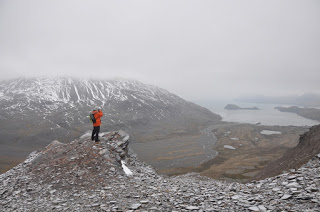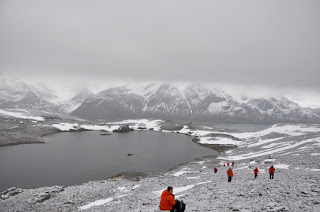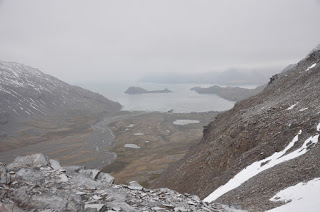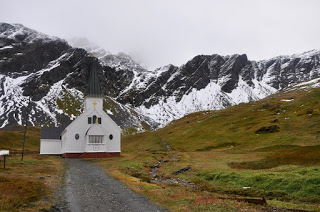This part 4 in an ongoing series I’m writing about my recent travels to the Falkland Islands and South Georgia with Lindblad Expeditions earlier this year. If you haven’t read the first three parts, and would like to, you can find them here, here, and here.
In my last installment of my travelogue for this trip, I wrote about the arrival of our ship – the National Geographic Explorer – at South Georgia, and our first encounters with the amazing wildlife that we found there. That includes tens of thousands of penguins and seals, as well as the occasional dolphin and whale too.
But, South Georgia isn’t just a place to spot vast amounts of animals. Anyone who knows about the island, probably also know that it played a crucial role in one of the greatest survival stories in the history of exploration and adventure. It was the destination that Ernest Shackleton and his team desperately tried to reach after being stranded in the Antarctic for months back in 1915 and 1916. I won’t recount that tale here, as there are several great books to read on the subject, and I myself wrote an extensive article about the story for Popular Mechanics a few months back.
I arrived at South Georgia knowing Shackleton’s ordeal all too well, and I was excited to see the place that placed such a crucial role in the eventual rescue not only of the British explorer, but all of his men. I also knew that several years later Shackleton lost his life while on a return visit to South Georgia on his way to the Antarctic once again. I knew that his grave could be found there and at one point we would visit it. That was yet to come however, and we had several more adventures ahead of us before that would happen.
While visiting the island we made several more stops at places like Right Whale Bay, Rosita Harbor, and Prion Island. Each of those stops provided more encounters with wildlife, including several different species of penguins and albatross. At that point, seeing these creatures, along with hundreds of fur seals, and become common place, although it was no less magical. The wildlife that inhabits South Georgia is truly spectacular, hence the nickname “the Serengeti of the Southern Ocean.”
But, there was one day of our expedition that I was looking forward to more than any other. It was a day that would give us the opportunity to walk along part of the same route that Shackleton – along with Tom Crean and Frank Wild – trekked when they were forced to cross the island in search of assistance. The three men, along with three others, had spent 16 days at sea making an open ocean crossing when they went in search of rescue. When they arrived on South Georgia they discovered they were on the wrong side of the island, and had to cross the vast, wild, and largely unexplored interior to reach a whaling station that could lend a hand. And on one of our days visiting there, we would get the chance to hike the final few miles of that route.
The morning began early that day, as the Explorer was dropping off all of the trekkers on shore to being the trek immediately after breakfast. The march began by hiking upwards away from sea level, gaining several hundred feet along the way. The weather was cold and windy, and the ground was wet and muddy, making it a strenuous hike almost immediately. But once we reached the top of the ridge, we joined Shackleton’s route and began to march towards Stomness, the abandoned whaling station that he and his men stumbled into after being missing for months.
March on South Georgia can be a challenging month. The austral summer is fading in the Antarctic by that point, and the weather can be unpredictable. On the day of our hike, there was a definitely chill in the air and the wind added a bit of a bite. The brisk hike helped to keep us warm as we moved into some of the more remote areas of the island, which is even more wild and rugged than it appears from the shore.
Eventually we wandered past a beautiful blue lake that had been given the name Crean Lake after Shackleton’s trusted crew member. Apparently, Tom Crean fell into that body of water when they marched this way. At the time, the surface of the lake was covered in snow and he mistook it for solid ground. He learned the hard way that South Georgia can be a hazardous place to explore.
The landscapes of South Georgia are very different than the ones found in the Falklands. While those islands often offer vast, wide open, and sweeping vistas, South Georgia is more of a true wilderness, with towering mountains, snowy passes, frozen lakes, and desolate meadows. Both are beautiful in their own way, but I found the vast emptiness of South Georgia to be incredibly alluring, and given the choice, I’d love to go back to explore more of its interior.
As our trek continued, we eventually topped over a ridge and could see the shoreline once again far off in the distance. The Explorer had made her way around a nearby peninsula, and was pulling into a cove nearby, awaiting our arrival. Along the beach nearby was the remains of Stromness. The whaling station had been closed for decades, but many of its buildings and other structures still remain.
In order to get to the pick up point, we had to scramble down a steep hillside littered with ice, snow, and an abundance of loose scree. The descent wasn’t particularly harrowing, but you did have to watch your step. One wrong move would send you tumbling down a precarious slope that could certainly cause damage. None of us hikers wanted to see that happen, so we inched along at a slow, but steady pace. Shackleton, Wild, and Crean made the same descent much more quickly, choosing instead to ride a nearby waterfall down the hill. None of us were brave (read desperate!) enough to follow suit.
From there, it was a walk of several miles back to the beach, where were got a good look at Stromness. Visitors are forbidden from entering the old station since many of the buildings are in serious disrepair, but the manager’s house can still be spotted even from a distance. It was there that Shackleton and his two companions stumbled into when they reached help at long last. The manager reportedly knew the explorer, but could hardly believe that the man standing in front of him was Ernest Shackleton, who had become only a shadow of his former self after months of little food and sleep, not to mention exposure to the elements.
After completing our morning hike along Shackleton’s old route, we boarded the Explorer once again and headed off to another landing spot where we would once again trek across a remote section of the island. This time, we would hike into Grytviken, the only part of South Georgia that is still inhabited.
Once the whaling industry left back in the 1960’s, the workers and their families living on South Georgia went too. After all, it is an incredibly remote and challenge place to eke out an existence, and without work, there was no reason to stay. Today, just a couple of dozen people live there, most of which are part of the British research team that lives at a place called King Edward Point, which can be found not far from Grytviken.
Once a thriving whaling station, Grytviken is now a historical landmark that welcomes visitors who come by ship. It is home to a small museum about the history of the island, as well as a few other important buildings, including a church that is still used on occasion to this day. That church was first built back in 1913 and it remains an interesting draw to this day.
While most visitors come ashore along the beach, we arrived in Grytviken through the backdoor. A
number of the passengers on the Explorer chose to hike a remote trail that took us once again into the mountains, where we caught a glimpse of South Georgia’s wilderness. Even though it was summer, much of the trail was still covered in ice and snow, and flurries would occasionally fall from the sky. Still, the landscape was utterly beautiful, with very few signs of human life, save for a lakeside cabin used by the research team that we passed en route.
Upon arriving in Grytviken most of us spread out and began exploring the village. Unlike Stromness, we were able to wander amongst the remains of the old whaling station, while also visiting the museum and small gift shop. It was indeed a fascinating place, and one of the local residents did give us an extensive tour, explaining much more about the operations of the station and what it was like for the people that lived there.
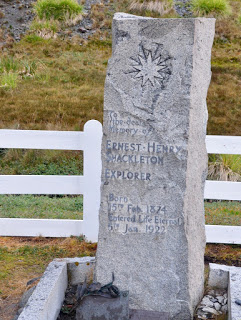 The last stop on our visit to the town was the local cemetery. It was there that we discovered the gravesite of Shackleton himself, who suffered a heart attack on his attempt to return to the Antarctic in 1921 and died there in January of 1922. Much as he did in life, Shackleton towers above everyone else in the grave yard, with a headstone that stands out from all of the others.
The last stop on our visit to the town was the local cemetery. It was there that we discovered the gravesite of Shackleton himself, who suffered a heart attack on his attempt to return to the Antarctic in 1921 and died there in January of 1922. Much as he did in life, Shackleton towers above everyone else in the grave yard, with a headstone that stands out from all of the others.
After a long day of chasing his ghost across the island, we found the man himself at long last. As the sun faded in the west, we gathered around this grave and raised a glass of Irish whiskey to “the boss” as he was called by his men. He may be gone, but his shadow still looms large over South Georgia.
With that, we returned to the Explorer and prepared for more adventures to come. We had plans to see more of South Georgia before we turned back across the Drake Passage. Little did we know at that time that weather would force us to move on early, and return to the Falklands ahead of schedule. But that is a story for the next – and most likely final – installment.
Latest posts by Kraig Becker (see all)
- Gear Review: The Xero Scrambler Mid is an Ultralight Hiking Shoe for Spring - March 1, 2023
- Gear Review: Yeti Roadie 48 Wheeled Cooler - August 18, 2022
- Kristin Harila Continues Pursuit of 8000-Meter Speed Record - August 16, 2022
